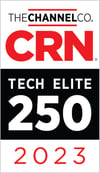Using passwords and PINs for access control has long been a source of humor, from George Costanza on Seinfeld choosing BOSCO as his ATM PIN to jokes about setting 1234 or ABCD as passwords.
However, the security inadequacy of passwords is a serious issue. The Microsoft Cyber Signals report found that in 2021, Azure blocked 25.6 billion brute-force attempts to breach enterprise customer accounts using stolen passwords.
Hackers can crack passwords easily using software tools. Often, companies neglect to change default passwords for third-party applications, leaving them vulnerable to a breach. Employees may also use the same password for more than one account.
Multi-factor authentication (MFA) has emerged as a stronger line of defense than passwords, offering layers of access control that weed out unauthorized users. With MFA, a password defense is fortified using 2 or 3 extra methods of authentication. These other authentication factors can be biological markers, such as a fingerprint; the answer to a personal question; or a security token.
Here’s a look at 5 security advantages of MFA:
1) Strict Identity and Access Management
Identity and access management is crucial for ensuring that sensitive information doesn’t fall into the wrong hands. Because MFA uses several factors, unauthorized parties can’t use a stolen password to gain access. Biometrics make it virtually impossible for hackers to assume an authorized user’s identity.
2) Proactive Security
MFA takes a preventative approach to security by denying bad actors access to information. Instead of remediating a breach after it occurs, MFA prevents it from occurring in the first place. Hackers are denied access at the point of a breach attempt, keeping them from infiltrating and moving laterally across the system.
3) Protection from Internal and External Threats
MFA can be used to prevent hackers from accessing critical information. Cyberterrorists often abuse credentials to gain access to privileged information, making MFA an effective defense against rogue nation-states. On the other hand, MFA ensures that employees only access information appropriate to their job role. This protects against internal threats from disgruntled employees or human error.
4) Multi-Layered Security
The more hoops hackers need to jump through, the less likely they are to compromise or steal your company information. Instead of using one layer of security by relying on a password, companies that adopt MFA can benefit from several layers, such as requiring a user to enter a one-time access code that has been sent to a second authorized device to proceed with an access attempt. Evidence of identity may be something the user possesses, such as a security token, or something the user knows, such as the answer to a personal question.
5) Part of Zero Trust Approach to Security
MFA solutions can be included as part of a Zero Trust Architecture (ZTA), which supports the principles of never trust; always verify. MFA assumes any access attempt on the network, whether internal or external, is suspicious. Successive authentication factors verify that the user is allowed to see the protected information. Zero Trust security is recommended by the U.S. government and the National Institute of Standards and Technology (NIST).
Modernizing Your Approach to Security
Today’s security strategies follow Zero Trust principles and are multi-layered. MFA should be part of such a strategy. With cybersecurity threats becoming more and more sophisticated, your company must adopt the strongest security practices available.
ProActive Solutions works with companies to develop modern security strategies and ZTAs using leading security technologies. We can help you design a robust security architecture that includes MFA and other infrastructure security tools.
Learn more about how MFA can help your organization meet its security goals. Set up a whiteboard session with a ProActive security expert.



